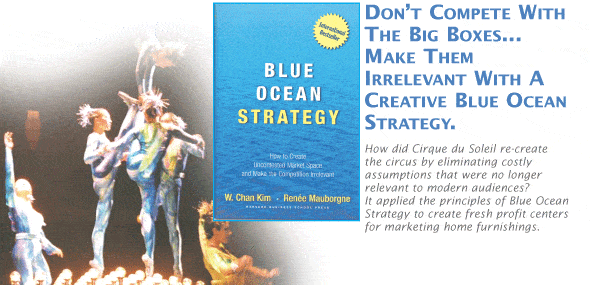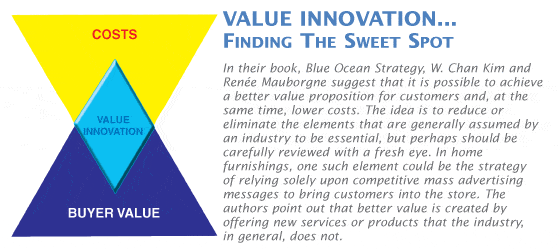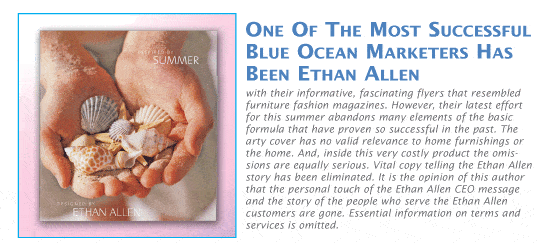Part 1: Compete with the big box stores using a creative Blue Ocean strategy.
Marketing furniture is all about beating competition, isn’t it? I mean, you win by dominating the media with constant price-item messages that no one else can compete with, using killer closing techniques, and delivering the merchandise the same day. Right? Wrong. At least, this is not the way to survive if you are an independent furniture store. You will get eaten alive in this blood-red ocean of kill or be killed. This article is about a new, innovative approach: Blue Ocean marketing. Blue Ocean is about using your time and imagination to create uncontested market space that will make the big boxes and other competitors irrelevant.
Sound too good to be true? Not only is the concept viable, it is based upon a study of 150 strategic moves spanning more than 100 years and 30 different industries. The Blue Ocean Strategy was developed by W. Chan Kim and Renée Mauborgne. It is a very different idea than the “Good to Great” approach we’ve discussed in past articles, that focused on successful strategic moves rather than the methods of “great” companies. After years of careful research, Kim and Mauborgne were unable to find any consistently excellent companies over the long haul. What they found was a consistent pattern when a company successfully executed a Blue Ocean strategy … such as Ford’s Model T in 1908 or GM’s 1924 breakthrough in automobile styling. Great product innovations provided heroic marketing breakthroughs, but they were not sustained interminably. Current Blue Ocean successes, such as Starbucks, or Southwest Airlines, or Cirque du Soleil will fade unless they discover fresh blue oceans to explore. Blue Ocean breakthroughs, however, demonstrated a consistent pattern regardless of time periods or industries. Historic turnarounds and revolutionary strategic coups all followed a repeatable Blue Ocean pattern. Once you understand the pattern, you can apply Blue Ocean strategies to your business with repeatable success.
An objective reviewer of the retail and manufacturing elements of the furniture industry might come to the conclusion that our industry is overcrowded, and that many retail entities are sinking in a shrinking red ocean. This furious competition results in less ROI and wears out everyone… from the entrepreneur to the sales person, to the delivery crew. But I don’t have to tell you this. The purpose of this two-part series is to describe the Blue Ocean concept and its relevance to the furniture industry of today. Part two will give ways for an independent furniture store to begin implementing the strategy.
A Story of Blue Ocean Innovation
Imagine the frustration of Walt Disney many years ago. He was creating great products in a very competitive industry: the movies. But he was working day and night and he wasn’t making any money. In fact, Disney owed Bank of America four million dollars by 1948. His animated movies were popular, but they were very labor intensive, and very expensive. Then Walt found a tiny outlet into a Blue Ocean that changed everything. Like all great Blue Ocean breakthroughs, this innovation was based upon a problem customers faced, and no one had addressed, let alone solved. Disney encountered this particular problem in a place very distant and far afield from movies. He encountered it in an amusement park.

One day Disney took his little girls to a popular amusement park. It was not the pleasant experience he had hoped it would be. The park was hot and dirty. The paint was pealing, and the operators of the rides were borderline unsavory characters. The food was awful and overpriced. That day Disney began to wonder what an amusement park would be like if it was taken to a whole new level. He developed a vision of a place for families that was wholesome and clean, in an environment that would create joyful childhood experiences.
Eventually, Disney took his ideas to the bankers. One asked: “Walt, why would you want to waste your efforts creating a big carnival? They are terrible places. They are hot and dirty …” and so on. Walt replied: “That’s why. But this will not be a bigger carnival. It will be something new, something the world has never seen.”
On a hot day in July, 1955, Disneyland opened. It was a stunning success. Of course it was, there was no competition. Disney would have his Blue Ocean for many years to himself. Disney’s debt now exceeded 10 million dollars. But that would begin to melt away because attendance at Disneyland exceeded all expectations. In just seven weeks over a million people had attended the park. After 30 years of precarious financial stress, Disney began raking in money. Less than a year after the opening, Walt was driving home, and as he waited at a light he spotted a beautiful red Mercedes Benz coup in a showroom window of a car dealer. He thought, “Gee, I wish I could afford that.” He drove for a few blocks and thought, “But, I can!” And he turned around and went back and bought it.
Cirque du Soleil Redefines A Dying Industry
A more modern Blue Ocean success was achieved by a one-time accordion player who had a vision of a new kind of circus. Cirque du Soleil achieved revenues in twenty years that exceeded the gross volume that Ringling Bros. and Barnum and Bailey took over one hundred years to achieve. And Cirque du Soleil did it in an industry that was on the decline. Alternate forms of entertainment were crowding out the circus. Attendance, revenues and profits had been nose diving for years. Cirque du Soleil did not contest with Barnum and Bailey for the shrinking universe of customers. Instead, like Disney, they created an uncontested market that made the Barnum and Bailey circus irrelevant.

Don’t get me wrong. There will always be red oceans. In the furniture industry supply is exceeding demand as never before. And the water is getting redder as stores compete for customer dollars. To survive at all, you must be good at what you do. But being good is not enough anymore, it is time to go beyond red ocean competition and seize new profit and growth opportunities. To succeed, you will need to begin to create and cultivate your own Blue Oceans.
How? By looking very closely at the model of Cirque du Soleil and then applying it to your retail furniture store strategies. Cirque du Soleil did exactly what Ford did in 1908 and what GM did in 1924. In each case, the company found a way to address the customer’s needs in an innovative way. Once they had a vision, all that was needed was to obtain the resources and energy required for their idea to become reality. Remember, this is not easy, but the stakes are high and the rewards are great. Blue Ocean strategies are not pipe dreams. Properly executed, they are practical, controlled risk strategies for systematically pursuing and capturing uncontested Blue Oceans.

Value Innovation: Giving More for Less Cost
The cornerstone of a successful Blue Ocean strategy is value innovation. Rather than a slow, incremental value-added improvement, equal measures of value and innovation are applied to vault the product beyond what we imagine buyers are willing to accept and pay for. Traditionally, it has been accepted that there is a value-cost trade off. In other words, you can give a customer more value at a higher cost or a reasonable value at a lower cost. You must choose. However, Blue Ocean proposes a concept of simultaneously pursuing value innovation and lower cost. Sound impossible? Suspend disbelief while we examine how Cirque du Soleil did just that. This concept lies at the heart of creating a successful Blue Ocean breakthrough.
Conventional wisdom in the circus industry insisted that a successful circus needed star-power, animals, and three rings of action. It also had to make lots of money from food concessions. So the industry fought over a limited universe of expensive talent (It would be reasonable to compare this central premise of the circus industry with a sacred cow of furniture retailing: To beat competition you need to dominate media with expensive advertising. But more on this later.) Cirque du Soleil brushed aside the assumptions and benchmarks of the ordinary circus, thus making competition irrelevant. The first step was to examine the expensive assumptions: star-power, animals, and three rings of non-stop action. Remember this first step: Examine the assumptions you (and your competitors) take for granted.
In the case of Cirque du Soleil it was decided that the names of the “stars” of the circus, both performers and clowns, are relatively unknown in the public mainstream. They had virtually no authentic drawing power. Next, the animals had less and less appeal, since many people had started feeling uncomfortable with their exploitation. Moreover, the cost of maintaining animal acts was huge. The three ring concept was also examined, and it was discovered that, not only was this expensive, people had trouble following what was going on. So, like stars and animals, the relevance of the three ring action was called into question. Finally, the profit center of aggressive concession sales was looked at. Once again, these sales had a negative effect on customers. The food was poor and overpriced, and the buying audience felt they were being had. So, what was left of the classic circus allure? Only the tent, the clowns, and the acrobats. How could these be combined in a unique way to make a more attractive experience for customers?

The Cirque du Soleil concept was based upon theatre … the question to be addressed was: what really makes for a great show? Certainly not sawdust floors and hard benches. A new theatrical environment was postulated … featuring comfortable, plush seats in wholesome surroundings. The tent was stylized to deliver a fresh, thematic visual experience. Clowns were retained, but not the slapstick kind of the old circus. A new, more sophisticated, gracious kind of performer was developed. The exciting acrobat acts were retained, but these were orchestrated into glittering and glorious production numbers. Cirque du Soleil created a Blue Ocean entertainment experience unlike anything P.T. Barnum ever dreamed of. Original music scores, costumes, lighting and timing drives the theme of each production. The result is a vastly more satisfying and sensual adventure than the old-time circus.
Like Disneyland, Cirque du Soleil paid no heed to what competitors did. Rather, they reframed the problem and offered a better solution. They created a better circus with more excitement and thrills, plus they added a dividend of artistic creativity and intellectual stimulation. New circus customers appeared from nowhere and were willing to pay theatre-prices for the unparalleled experience.
Blue Ocean Opportunities for Selling Furniture
I have told the above story to several furniture entrepreneurs. A few had a light come on in their eyes. And they all asked the same question: Is it possible to apply this idea to selling furniture? Indeed it is, but it requires a carefully crafted plan and a concentrated effort. But, where to start?
Let’s begin with a bit of value innovation. Consider: How can we give the customer more value than competitors at less cost? At this point you may feel like leaping to your feet and exclaiming: “Are you kidding? My mark can’t take another hit!” But before you do that, consider the assumptions that burden too many furniture professionals.
Advertising as a fixed expense is one. It is unbelievably expensive to get a single customer in the door these days. Big box outfits don’t hesitate to require a ten percent advertising budget of their dealers. Thus the market is flooded with low margin price-item ads … looking much the same and lacking in flair or personality. But, old-fashioned as they are, the sheer volume of these ads manages to put a squeeze on independents. On the other hand, it is an assumption that advertising must be a fixed expense—rather than an investment that must justify itself and pull its own weight. Is it just possible that this idea has become a sacred cow… similar to the stars and animals in the old-time circus. This is not a comfortable confession for a professional adman to make, but my experience says that perhaps it is.
An Unexpected Profit Center
Years ago while working with a small furniture store in Pennsylvania, I noticed that one well-dressed saleslady almost never worked the floor, but spent most of her time on the phone. She was in charge of a “house calls” program of her own creation, and was one of the store’s top producers. This was long before house calls became a common strategy for stores. A trained decorator, she enjoyed going to homes, exploring the problems of customers, and providing solutions.
oreover, she produced her own leads. Unlike the typical sales person who spends down-time chatting or surfing the net, she created her own leads for evening house calls. By doing this, she had solved the twin problems of high retail advertising costs and the down-time wasted by most retail salespeople.
In the October/November issue of FURNITURE WORLD Magazine we will look at how a larger store developed a highly successful house calls program that achieved a closing ratio of over 90%. Although we will examine how this store structured and implemented the program, the main thrust of the article will be on how Blue Ocean strategies can challenge the status-quo of furniture retailing as we know it.
Specifically, we will focus on the prohibitive cost of bringing customers into our stores and also on the enormous waste created by salesperson down-time. In the next installment, several Blue Ocean ideas will be presented that challenge these—and other “realities” that are presumed to be unavoidable difficulties related to furniture retailing.
The long range goal of this Blue Ocean effort is to stimulate your creative juices, and to motivate you to begin utilizing the enormous creative talent of many of the people who sell your furniture. Younger workers commonly want opportunities to learn and have greater control of their destinies. A few brainstorming sessions with them on Blue Ocean concepts will yield a rich harvest of ideas. We will also examine these techniques in the next installment.
In the meantime, please email any Blue Ocean ideas and observations you’ve already come up with to mullins@furninfo.com.
Contributing Editor Larry Mullins has 30+ years experience in the front lines of furniture marketing. Over the past ten years he has developed a Visionary Management program that can impact the culture of an entire organization and bring it to life. He also produces state-of- the-art promotional advertising packages for everything from quick cash flow to complete exit strategies and store closings. Larry is the President of UltraSales, Inc.. Questions on any aspect of this article can be sent to Larry care of FURNITURE WORLD at mullins@furninfo.com. See more articles by Larry in the marketing management archives on furninfo.com.